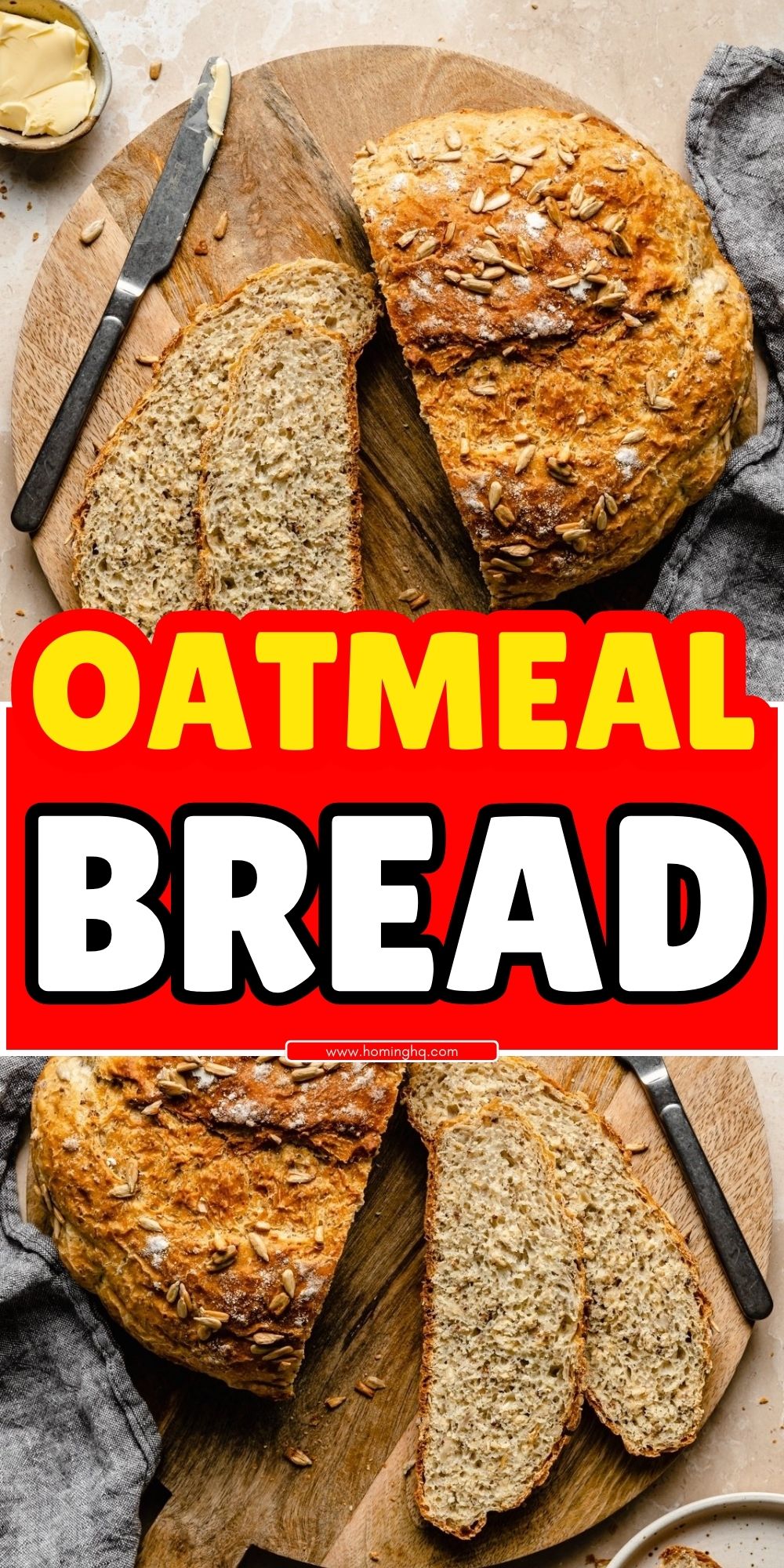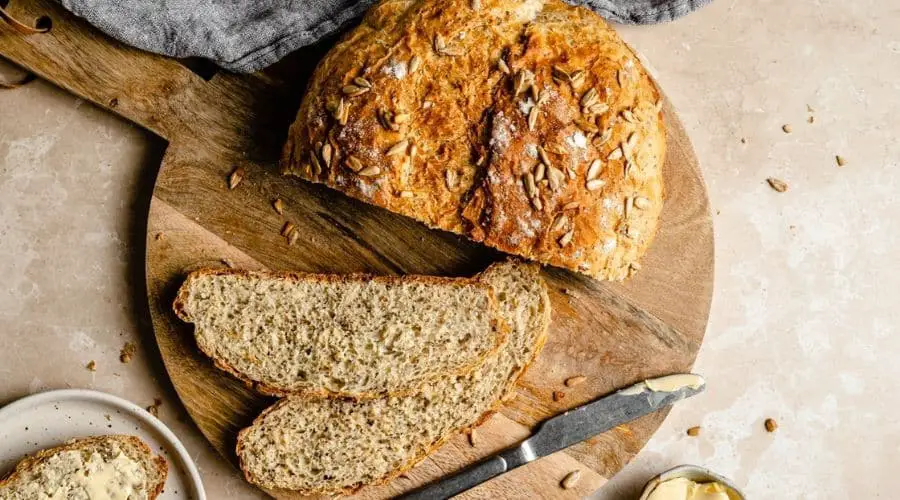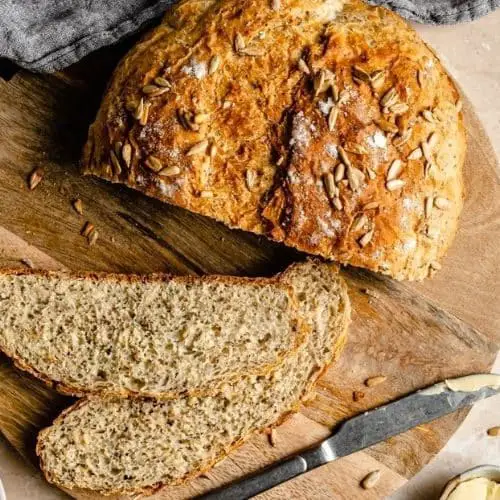All products are selected by our editorial team for quality. If you buy through our links, we may earn a small commission at no extra cost to you.
Oatmeal bread is a wholesome and hearty homemade bread that brings together the goodness of oats with the comforting softness of freshly baked bread.
Unlike regular white or whole wheat bread, oatmeal bread has a slightly chewy texture with a hint of natural sweetness, making it a perfect choice for those who love a nourishing loaf.
This bread is not only delicious but also packed with fiber, which helps keep you full longer.
Whether you enjoy it as a morning toast with butter and jam or use it as a base for a hearty sandwich, oatmeal bread is a versatile addition to any kitchen.
Plus, making it at home means you can control the ingredients, avoiding unnecessary additives while ensuring a fresh, preservative-free loaf.

Why You’ll Love This Oatmeal Bread Recipe
Oatmeal bread offers a balance of softness and heartiness, making it a favorite for both beginners and experienced bakers. Here’s why this recipe stands out:
A Soft Yet Hearty Texture
The combination of oats and flour creates a bread that is soft on the inside with a slightly crisp crust.
The oats add a gentle chew, making every bite satisfying.
Naturally Nutritious
Oats are packed with fiber, protein, and essential vitamins, making this bread more nutritious than traditional white bread.
It’s a great way to add whole grains to your diet without compromising on taste.
Easy to Make with Simple Ingredients
You don’t need any fancy equipment or hard-to-find ingredients.
This recipe uses pantry staples like flour, oats, honey, and yeast to create a perfectly balanced loaf.
Perfect for Any Meal
Oatmeal bread pairs beautifully with sweet or savory toppings.
It’s excellent for breakfast, a side with soups, or even as sandwich bread for lunch.
Ingredients You’ll Need
To make this oatmeal bread, you’ll need a handful of basic ingredients that work together to create a flavorful, well-textured loaf.
Key Ingredients
- Old-Fashioned Oats – These add texture and fiber to the bread. Quick oats can be used, but rolled oats provide the best consistency.
- Warm Water or Milk – Helps soften the oats and activate the yeast. Milk adds a slightly richer flavor.
- Honey or Brown Sugar – Provides natural sweetness and enhances the depth of flavor.
- All-Purpose or Bread Flour – Gives the bread structure and elasticity. Bread flour creates a chewier loaf, while all-purpose flour results in a softer texture.
- Active Dry Yeast – The leavening agent that helps the bread rise and develop a light, airy crumb.
- Butter or Oil – Adds moisture and a tender crumb to the loaf.
- Salt – Balances the flavors and enhances the overall taste of the bread.
Optional Add-Ins
- Nuts or Seeds – For added crunch and nutrition, consider mixing in sunflower seeds, walnuts, or flaxseeds.
- Cinnamon or Nutmeg – A touch of warm spice can elevate the flavor.
- Dried Fruits – Raisins or dried cranberries add natural sweetness and texture.
With these ingredients, you’re ready to create a flavorful oatmeal bread that’s both wholesome and delicious.
Step-by-Step Instructions to Make Oatmeal Bread

1. Prepare the Oat Mixture
Begin by combining the oats and warm water (or milk) in a bowl. Stir gently and let the mixture sit for about 10 minutes.
This step softens the oats and allows them to absorb the liquid, resulting in a moist and tender bread.
If you’re using milk, it will add a subtle richness to the flavor.
2. Mix and Knead the Dough
Once the oats have softened, add honey (or brown sugar), butter (or oil), and salt to the oat mixture.
Stir until the ingredients are well combined. In a separate bowl, whisk together the flour and yeast.
Gradually add the dry ingredients to the wet mixture, stirring until a dough begins to form.
Turn the dough onto a floured surface and knead for about 8–10 minutes, or until it becomes smooth and elastic.
If the dough feels too sticky, sprinkle in a little more flour, but be careful not to add too much.
The goal is a soft, slightly tacky dough that holds its shape without being overly sticky.
3. First Rise: Letting the Dough Rest
Place the dough into a lightly greased bowl and cover it with a damp cloth or plastic wrap.
Allow it to rise in a warm spot for about 1 hour, or until it doubles in size.
This process allows the yeast to work its magic, making the dough light and airy.
4. Shaping and Second Rise
Once the dough has risen, punch it down gently to release the air. Transfer the dough to a lightly floured surface and shape it into a loaf.
You can either form a round or oblong loaf, depending on your preference.
Place the shaped dough into a greased loaf pan, cover it again, and let it rise for another 30-45 minutes.
The dough should rise just below the top of the pan.
5. Baking the Bread to Perfection
Preheat your oven to 350°F (175°C). Once the dough has risen, place the loaf in the oven and bake for about 30–35 minutes.
The bread should have a golden brown crust, and when tapped on the bottom, it should sound hollow.
For an extra golden top, brush the loaf with melted butter before baking.
6. Cool Before Slicing
After baking, remove the bread from the oven and let it cool in the pan for about 5 minutes before transferring it to a wire rack.
Allow the bread to cool completely before slicing.
This helps the bread firm up and prevents it from becoming too crumbly.
Expert Tips for the Best Oatmeal Bread
Perfecting the Texture
For the best texture, make sure to use rolled oats (old-fashioned oats) rather than quick oats.
The rolled oats provide the ideal balance of chewiness and softness in the final loaf.
If you want a more uniform texture, you can grind some of the oats in a food processor before adding them to the dough.
Watch the Yeast
The yeast is the key to a light, airy loaf. Ensure that your yeast is fresh and active.
If you’re using dry yeast, proof it first by dissolving it in warm water with a pinch of sugar.
Let it sit for 5 minutes—if it becomes frothy, it’s ready to use.
Kneading Technique
Kneading is essential to developing the gluten, which gives the bread its structure.
Be patient, and don’t rush this process. If your dough feels too sticky, use just enough flour to keep it manageable.
However, avoid over-flouring, as this could result in a dense loaf.
Achieving a Golden Crust
For a beautifully golden and slightly crispy crust, brush the top of the dough with melted butter before baking.
This gives the bread a rich flavor and enhances the golden color.
Alternatively, you can also use milk for a softer, more delicate finish.
Storing the Bread
Once the bread has cooled, store it in an airtight container or wrap it in a cloth to keep it fresh.
Oatmeal bread tends to stay moist longer than regular white bread, making it ideal for meal prep.
If you’re not planning to eat it right away, you can freeze it for up to a month.
Just slice it before freezing so you can easily toast individual slices when you’re ready.
By following these expert tips, you’ll ensure your oatmeal bread turns out light, flavorful, and perfectly textured every time.
Serving Suggestions
Oatmeal bread is incredibly versatile and can be enjoyed in a variety of ways.
Here are some serving ideas to inspire you:
For Breakfast
Slice your oatmeal bread and toast it for a warm, comforting breakfast.
Spread on a generous layer of butter, honey, or your favorite fruit preserves.
You can also pair it with a scrambled egg or avocado for a more savory start to your day.
As a Sandwich
Oatmeal bread’s soft yet sturdy texture makes it perfect for sandwiches.
Try it with classic fillings like turkey and cheese, or get creative with roasted vegetables and hummus for a hearty, plant-based option.
The slight sweetness of the bread complements savory ingredients wonderfully.
With Soups and Stews
Serve warm slices of oatmeal bread alongside your favorite soups or stews.
The bread’s texture and flavor make it an ideal choice for sopping up broths and sauces.
Try it with tomato soup, a bowl of chili, or a creamy potato soup for a comforting meal.
For Snack Time
Enjoy a slice as an afternoon snack, perhaps with a slice of cheese or a smear of nut butter.
The oats in the bread offer long-lasting energy, making it a perfect snack to keep you satisfied until your next meal.
For Special Occasions
Oatmeal bread can also be served as part of a brunch spread.
Pair it with scrambled eggs, bacon, and fresh fruit for a well-rounded meal that guests will love.
Conclusion
Homemade oatmeal bread is a nourishing and versatile addition to any kitchen.
With its soft texture, subtle sweetness, and hearty flavor, it can be enjoyed at any time of day—whether as a comforting breakfast, a filling sandwich, or a delightful side to your favorite soups and stews.
By following this simple recipe and expert tips, you’ll be able to create a fresh, preservative-free loaf that will make you rethink store-bought bread.
We’d love to hear how your oatmeal bread turns out!
Whether you enjoyed it with a slather of butter, as part of a sandwich, or just by itself, share your experience and variations in the comments. Happy baking!
Frequently Asked Questions
1. Can I make oatmeal bread without yeast?
Yes, you can make a no-yeast version of oatmeal bread.
In this case, you would use baking powder or baking soda as the leavening agent instead of yeast.
The texture will be slightly different, but it will still be delicious!
2. What’s the best way to store homemade bread?
To store oatmeal bread, let it cool completely before wrapping it in a cloth or placing it in an airtight container.
It stays fresh for about 3-4 days at room temperature. For longer storage, slice the bread and freeze it in a resealable bag for up to a month.
3. Can I use quick oats instead of rolled oats?
Quick oats can be used in place of rolled oats, but the texture will be a bit finer.
Rolled oats give the bread more texture and chewiness, so for the best results, we recommend using old-fashioned oats.
4. Can I add other grains or seeds to the bread?
Absolutely! Feel free to incorporate other grains like flaxseeds, sunflower seeds, or even whole wheat flour to make the bread even more nutritious.
Just be mindful not to overwhelm the dough with too many add-ins, as it could affect the texture.
5. Why is my oatmeal bread dense?
If your oatmeal bread turns out too dense, there could be a few reasons.
You may have used too much flour, over-kneaded the dough, or not allowed it to rise long enough.
To avoid this, make sure to follow the measurements carefully and give the dough enough time to rise and develop properly.

Oatmeal Bread
Equipment
- 1 large mixing bowl
- 1 Loaf Pan (8 x 4 inches)
- 1 Small bowl (for proofing yeast)
- 1 whisk
- 1 Spoon for mixing
- 1 towel or plastic wrap (for covering dough)
- 1 Wire rack (for cooling)
Ingredients
- 2 cups 200g rolled oats
- 1 ½ cups 360ml warm water or milk
- 1 tablespoon 15g honey or brown sugar
- 1 tablespoon 14g butter or vegetable oil
- 1 teaspoon 5g salt
- 2 teaspoons 6g active dry yeast
- 3 cups 360g all-purpose or bread flour
- 1 tablespoon 14g butter (optional, for brushing)
Instructions
Prepare the Oat Mixture
- Combine the oats and warm water (or milk) in a bowl and stir. Let the mixture sit for 10 minutes to soften the oats.
Mix and Knead the Dough
- Add honey (or brown sugar), butter (or oil), and salt to the oat mixture and stir well. In a separate bowl, whisk together the flour and yeast. Gradually add the dry ingredients to the wet ingredients, stirring until a dough forms. Transfer the dough to a floured surface and knead for 8–10 minutes, until smooth and elastic.
First Rise
- Place the dough in a greased bowl, cover with a damp cloth or plastic wrap, and let it rise in a warm spot for about 1 hour, or until doubled in size.
Shape and Second Rise
- Punch the dough down to release air, then shape it into a loaf and place it in a greased 8×4-inch loaf pan. Cover and let it rise for another 30-45 minutes until the dough has risen just below the top of the pan.
Bake the Bread
- Preheat your oven to 350°F (175°C). Brush the top of the loaf with melted butter (optional) for a golden finish. Bake for 30–35 minutes, or until the bread sounds hollow when tapped on the bottom.
Cool and Serve
- Let the bread cool for 5 minutes in the pan, then transfer it to a wire rack to cool completely before slicing.
Notes
- Texture Tips: For a lighter loaf, use bread flour instead of all-purpose flour. Bread flour has a higher protein content, which helps create a chewier texture.
- Storage: Store leftover oatmeal bread in an airtight container at room temperature for 3-4 days. Alternatively, slice and freeze it for up to a month for easy access to fresh bread.
- Add-Ins: You can enhance the flavor of your oatmeal bread by adding seeds, dried fruits, or nuts like sunflower seeds or raisins to the dough before the second rise.
- No Yeast Option: If you prefer a no-yeast version, use 1 tablespoon of baking powder for a quick alternative. The bread won’t rise as much, but it will still be delicious.

